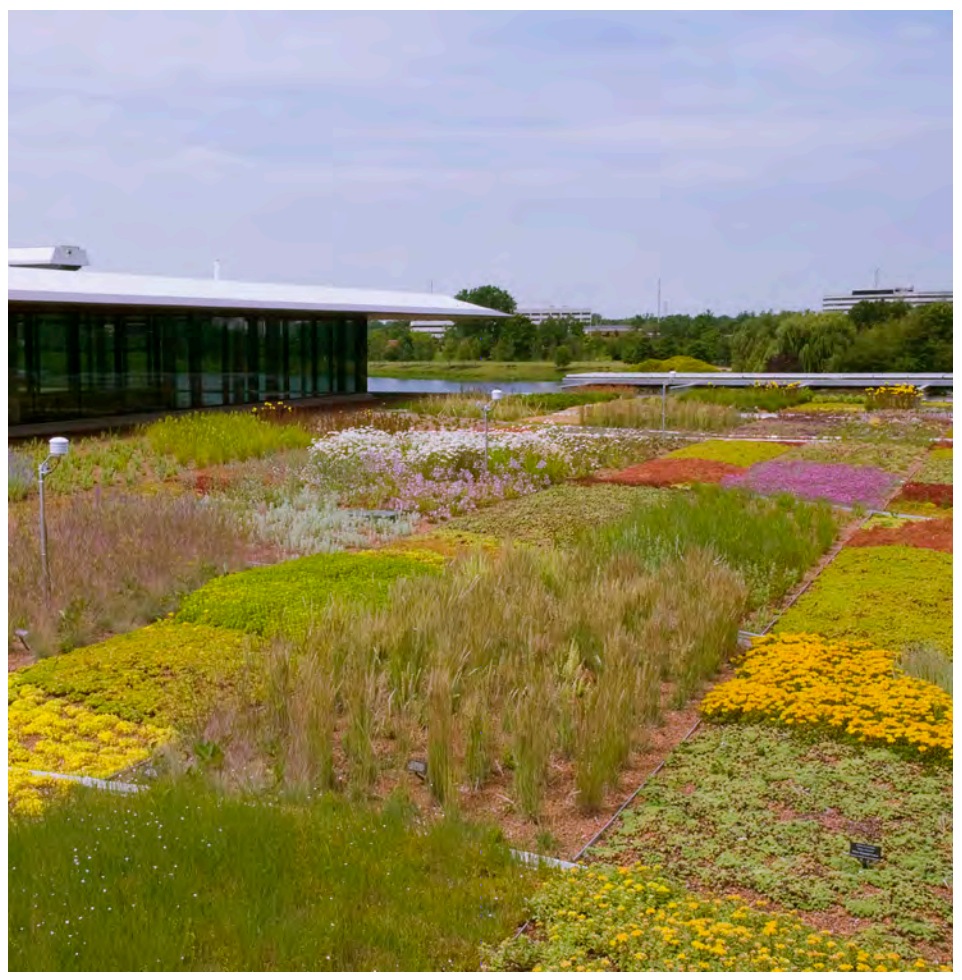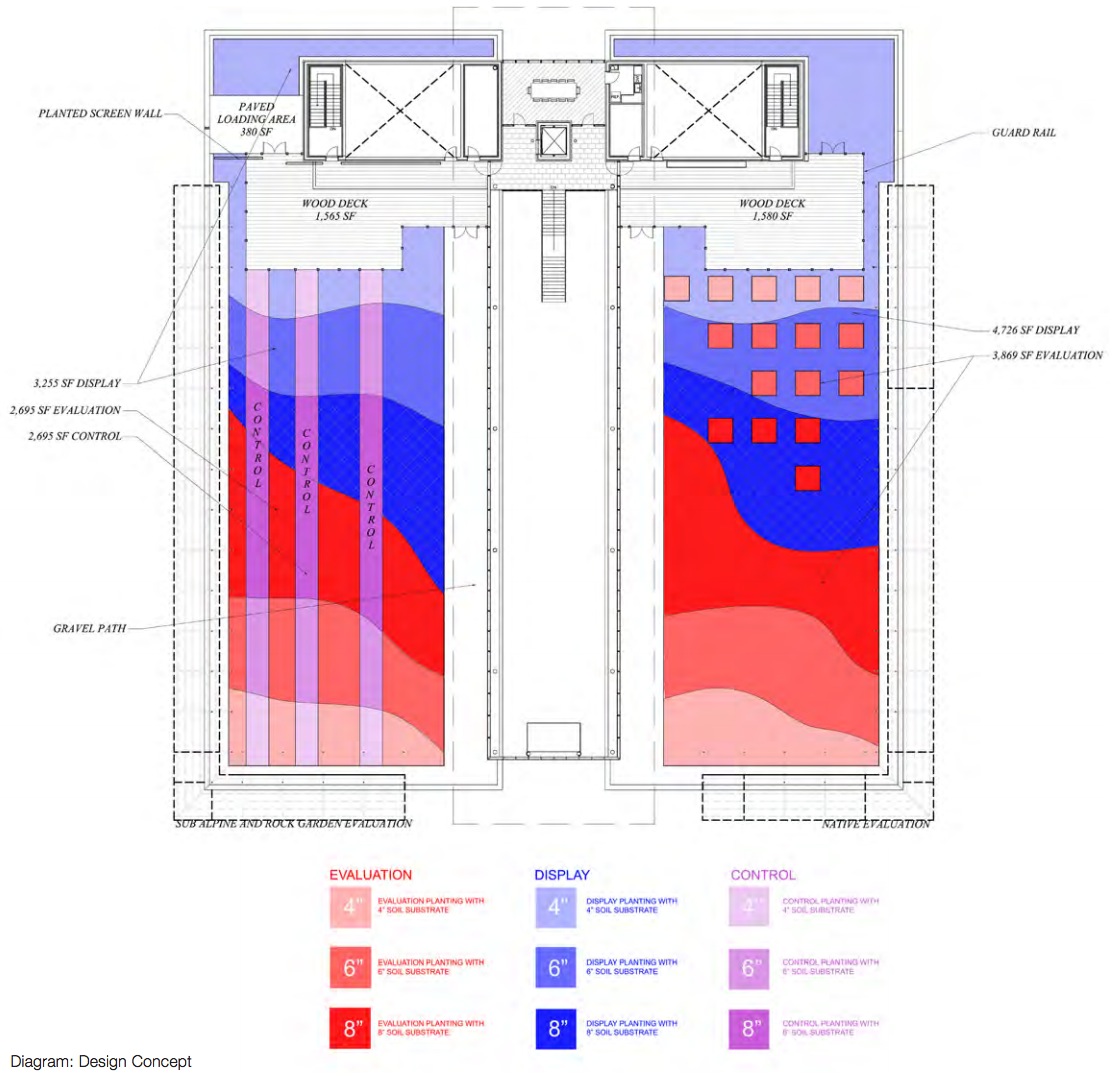CHICAGO BOTANIC GARDEN
 The significance of green roofs in urban areas has steadily increased over the past 20 years. In the United States, as well as worldwide, green roofs have become vital components of new construction on a broad variety of buildings, from municipal to commercial and industrial to residential. The benefits of green roofs are measured in environmental, economic, and aesthetic or cultural ways. In its simplest form, a green roof may contain a sampling of sedums or other hardy succulents, but many modern green roofs have increased the range and diversity of plants being grown by installing deeper growing media and changing the way green roofs are viewed or utilized. Whether strictly utilitarian or highly specialized and ornamental, green roofs have a variety of benefits over a traditional roof.
The significance of green roofs in urban areas has steadily increased over the past 20 years. In the United States, as well as worldwide, green roofs have become vital components of new construction on a broad variety of buildings, from municipal to commercial and industrial to residential. The benefits of green roofs are measured in environmental, economic, and aesthetic or cultural ways. In its simplest form, a green roof may contain a sampling of sedums or other hardy succulents, but many modern green roofs have increased the range and diversity of plants being grown by installing deeper growing media and changing the way green roofs are viewed or utilized. Whether strictly utilitarian or highly specialized and ornamental, green roofs have a variety of benefits over a traditional roof.
The environmental benefits include conserving water, reducing interior noise pollution, mitigating stormwater runoff, reducing the urban heat-island effect, improving urban air quality through carbon dioxide-oxygen exchange, and creating habitats for a diversity of birds, insects, and animals. Along with extending the life of the roof by two to three times over a conventional roof, economic benefits include reducing energy costs—both heating and cooling—increasing property values, and meeting requirements for stormwater management. Providing an aesthetic amenity space for building occupants and pleasing views from within or from a distance, creating green space in urban environments, attracting wildlife, and growing food crops are all cultural benefits of green roofs.
While the type of green roof is based on the building and user needs, green roofs are increasingly being developed for their cultural aspects, that is, it is becoming more common for green roofs to provide interactive and amenity space for building occupants or the general public. With this usage comes a desire to have greater plant diversity so that the green roof functions on an environmental level as well as provides a pleasing landscape. Green roofs are classically described by the depth of the growing medium—extensive, semi-intensive, and intensive. Extensive green roofs have a growing depth of 3 to 6 inches, and are typically lighter in weight with a saturated weight of 15 to 30 pounds per square foot. This fairly shallow growing medium supports a limited plant palette, often kept to drought-tolerant hardy succulents. Extensive green roofs are popular with homeowners and large industrial, commercial, and municipal buildings where the environmental and economical benefits are most valued. Semi-intensive green roofs are a heavier system, with a saturated weight of 30 to 50 pounds per square foot, and a growing medium of 6 to 12 inches. The greater growing depth supports a wider variety of perennials, grasses, and shrubs, which creates a more gardenlike landscape. Depending on the regional climate, irrigation may be necessary and more maintenance may be required to keep the semi-intensive green roof looking good. With a saturated weight greater than 70 pounds per square foot, intensive green roofs are the heaviest and have growing depths greater than 12 inches. This type of roof is commonly designed for access by people, supports shrubs and trees, and has higher maintenance needs.
When choosing plants for green roofs it is important to understand that a green roof is not the equivalent of a typical landscape elevated to the top of a building; therefore, appropriate consideration must be given to a plant’s growth habit, native ecosystem, and cultural needs, to name a few factors. Many common garden plants will not survive on a green roof. In Green Roof Plants, Ed and Lucie Snodgrass succinctly describe the ideal traits for a good green roof plant—“The most successful green roof plants are low-growing, shallow-rooted perennial plants that are heat, cold, sun, wind, drought, salt, insect, and disease tolerant. Green roof plants should also have a long life expectancy or the ability to self-propagate, and they should require minimal nutrients and maintenance.” Needless to say, selecting the right plants for green roofs is anything but simple. The Snodgrasses’ words bear out the challenge of finding plants suited to the harsh growing conditions on green roofs.
The Chicago Botanic Garden’s Green Roof Garden
In September 2009, the Chicago Botanic Garden opened its Daniel F. and Ada L. Rice Plant Conservation Science Center, a 38,000-square-foot LEED Gold-rated research and laboratory facility designed by Booth Hansen, a Chicago-based architectural firm. Atop the Center is a 16,000-square-foot green roof, divided into two 8,000-square-foot gardens that display a variety of North American native plants and exotic plants from around the world. The Green Roof Garden of the Chicago Botanic Garden consists of the Josephine P. & John J. Louis Foundation Green Roof Garden North and the Ellis Goodman Family Foundation Green Roof Garden South. The Green Roof Garden is both a living laboratory and a beautifully designed garden enjoyed by visitors year-round.
Download full version (PDF): An Evaluation Study of Plants for Use on Green Roofs
About the Chicago Botanic Garden
www.chicagobotanic.org
We believe: The future of life on Earth depends on how well we understand, value, and protect plants, other wildlife, and the natural habitats that sustain our world…We believe: Beautiful gardens and natural environments are fundamentally important to the mental and physical well-being of all people…We believe: People live better, healthier lives when they can create, care for, and enjoy gardens.
Tags: Chicago, Chicago Botanic Garden, Green Roof, IL, Illinois







 RSS Feed
RSS Feed